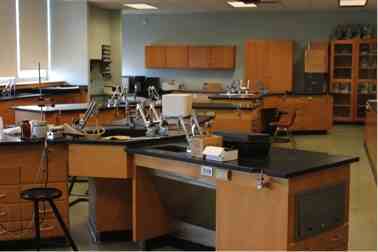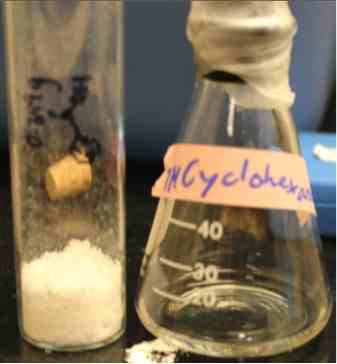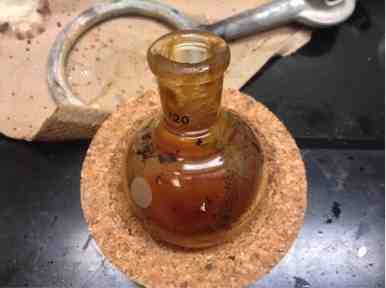Green Molecules and Green Chemistry Labs: Johnny Mendoza, PSF Summer Experience

The last time I had been in this chemistry lab was 2 years ago. Back then, I was just getting my feet wet in the field of organic chemistry with the aid and guidance of my professor, Julia Robinson-Surry (’06). Now, I’m working with Julia and the lab teaching assistant, Cindy Liu, to dive deep into the field of green chemistry. With their help, I plan on revamping the current organic chemistry lab curriculum at Bard High School Early College Queens, my old high-school, in an attempt to make it more environmentally-friendly. In addition, I hope to learn about the role and synthesis of green catalysts in organic chemistry, specifically Julia’s work with Fe-TAMLs, a group of oxidation catalysts that has proven useful in environmental cleanup efforts.
Bard Queens is a small school. With 600 students on two floors, it didn’t always feel that way, but the average class size is 20 students. It is also a new school, at only 6 years of age. This comes with some inherent difficulties. For example, the chemistry lab at Bard is not as well endowed as Reed’s. For one thing, there are only two fume hoods, one of which is not working. The only way these chemistry students can characterize their product is through infrared spectroscopy (IR) or physical analysis (i.e. matter state, melting point, boiling point, chemical assays, etc.). In most organic chemistry labs, nuclear magnetic resonance spectroscopy (NMR) and gas chromatography–mass spectrometry (GC-MS) are standard analytical methods. Our project must keep these limitations in mind, and design labs that can be preformed mostly on the bench-tops, while avoiding volatile/strong-smelling chemicals and synthesizing products that can be differentiated readily from any reagents used.
Bard Queens also employs a relatively unique curriculum, where the first two years of school are dedicated to fulfilling high-school requirements and the last two years dedicated to taking college courses with the goal of graduating with an associate’s degree. The students taking organic chemistry here are generally 2 years younger than those at other colleges. The lab periods are also shorter (2 hours, 40 mins vs. 4 hours at Reed). One of our goals will be to make these labs accessible yet rigorous, worthwhile yet not time-consuming, and above all, interesting.

The two products above were synthesized using household bleach as the main reagent. The vial on the left contains benzoic acid, the product of a haloform reaction using acetophenone; this reaction normally requires halogenation using chlorine, bromine, or iodine in their elemental form. The use of bleach as the halogenating agent replaces the use of the hazardous elemental halogen reagents, making the reaction a plausible undergraduate experiment. Even so, the yields for this experiment are low, something we are trying to improve. The flask on the right contains cyclohexanone, the product of the oxidation of cyclohexanol. The oxidation of secondary alcohols to ketones is generally achieved using chromium-based reagents, which are highly-reactive and toxic. Using bleach as an oxidizing agent would allow these students to perform an important chemical transformation that they might not otherwise be exposed to.

This experiment used baker’s yeast to reduce the ketone in ethyl acetoacetate to an alcohol. At Reed, we used sodium borohydride as a reducing agent, an inorganic chemical that must be handled with care due its high-reactivity. Although the above reaction proceeds slowly (it takes a few days to achieve high-yields), the waste generated is aqueous, and can be dumped down the drain after evaporation of any residual organic solvent. The first attempt at this experiment yielded a minute amount of product due to decomposition after distillation (the brown goop smelled like rancid teriyaki-sauce, and the distillate like rancid apple juice), a mistake I was not aware I made until Julia pointed it out to me. Cindy managed to salvage some product using a liquid-liquid extraction so we will try this experiment again using this method. The experiment, while slow, requires minimal preparation, and can be performed in tandem with another experiment, making its incorporation into any curriculum simple.
At first, my time in the lab was stressful (working in the lab from 9am-4pm takes its toll). I’ve always been nervous in the lab, but Julia and Cindy have made me feel at home here. The freedom they have given me in the lab has me daydreaming of experiments I want to perform, and new directions I want to pursue. I can feel the nerves being replaced with excitement. Learning about alternative synthetic routes that are environmentally-friendly and feasible in our modest high-school lab makes me smile like a fool. I cannot wait to hear about the green molecules Julia synthesized at Reed with Alan Shusterman, brainstorm about the things we can do at Bard, or ideas I can take back with me to Reed.
Until Next Time!
Tags: presidents summer fellowship, organic chemistry, research, chemistry, environmental science, psf
